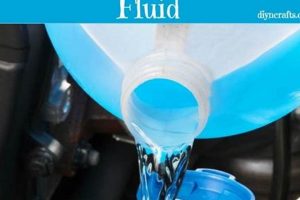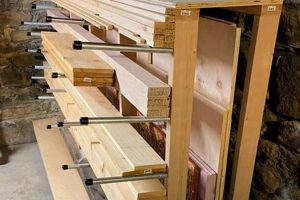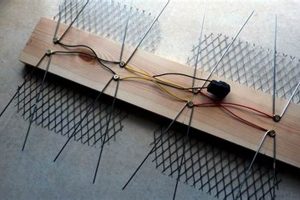A system designed for maintaining the dryness of 3D printer filament through controlled storage. Such setups typically involve a sealed container, desiccant to absorb moisture, and a mechanism for feeding the filament directly to the printer, thereby minimizing exposure to humid environments. An example includes repurposing an airtight food container and filling it with silica gel packs.
Maintaining low moisture levels in filament is crucial for successful 3D printing. Hygroscopic filaments, such as nylon, PETG, and some polycarbonates, readily absorb moisture from the air, leading to print defects like stringing, popping, and weakened layer adhesion. Historically, users have employed ovens or dedicated filament dryers to address this issue. However, purpose-built enclosures offer a more practical and consistent solution, allowing for continuous printing without the need for pre-drying.
The subsequent sections will delve into the specifics of constructing enclosures, outlining material selection, design considerations, and operational best practices for optimal filament preservation and printing performance.
Construction and Usage Tips
The following provides guidance for building and effectively utilizing a customized filament moisture control unit. These suggestions emphasize practicality and optimal filament condition maintenance.
Tip 1: Container Selection: Choose an airtight container appropriate for filament spool size. Rubber-sealed containers or those with secure locking mechanisms are optimal for maintaining a low-humidity environment. Ensure the chosen container is chemically compatible with the filament and desiccant.
Tip 2: Desiccant Implementation: Use rechargeable desiccant materials such as silica gel or molecular sieves. Employ sufficient desiccant volume based on container size and ambient humidity levels. Regularly recharge or replace desiccant to ensure ongoing moisture absorption capacity.
Tip 3: Filament Routing: Implement smooth filament routing through the enclosure. Employ PTFE tubing or low-friction guides to minimize drag and prevent filament breakage during printing. Consider the placement of inlet/outlet points to optimize airflow.
Tip 4: Humidity Monitoring: Integrate a digital hygrometer within the enclosure for constant humidity level monitoring. Establish a threshold for humidity to trigger desiccant recharging or replacement procedures. Record humidity data to track performance over time.
Tip 5: Controlled Environment: Position the enclosure in a location with stable temperature and minimal direct sunlight exposure. Temperature fluctuations can affect humidity levels and desiccant performance. Shielding from UV light protects certain filament types from degradation.
Tip 6: Sealing Integrity: Routinely inspect the container seals for damage or degradation. Replace seals as needed to maintain airtight conditions. Ensure all entry and exit points for filament or cables are adequately sealed.
By adhering to these suggestions, individuals can optimize self-assembled filament moisture control systems, mitigating the risks associated with moisture absorption and ensuring consistent 3D printing outcomes.
The ensuing section will address potential challenges and troubleshooting strategies related to filament preservation and usage in a moisture-controlled setting.
1. Airtight Container Selection
Airtight container selection forms a cornerstone of effective filament management, directly influencing the performance of a self-assembled storage solution. The choice of container dictates the system’s ability to maintain a low-humidity environment, crucial for preserving filament quality and ensuring consistent 3D printing results.
- Material Composition and Permeability
The container material determines its barrier properties against moisture ingress. Plastics like polypropylene (PP) or polycarbonate (PC) offer varying levels of impermeability. Lower-grade plastics may exhibit higher moisture vapor transmission rates, compromising the system’s long-term effectiveness. For instance, thin-walled containers may allow gradual moisture permeation, necessitating more frequent desiccant regeneration.
- Sealing Mechanism Integrity
The sealing mechanism is paramount for achieving airtightness. Rubber gaskets, O-rings, or robust clamping systems are common approaches. Deterioration or improper sealing can lead to moisture infiltration. A damaged or poorly designed seal can negate the benefits of an otherwise impermeable container, illustrated by visible condensation forming within a compromised unit.
- Size and Volume Considerations
Container volume dictates the desiccant quantity required to maintain a low-humidity environment. An undersized container may limit desiccant capacity, resulting in insufficient moisture absorption. Conversely, an excessively large container increases the initial desiccant requirement and may lead to inefficient desiccant utilization. Proper sizing ensures desiccant saturation occurs at a manageable rate.
- Durability and Resistance to Environmental Factors
The container’s durability is crucial for long-term reliability. Resistance to impacts, temperature fluctuations, and UV exposure is essential. A brittle container may crack or warp, compromising airtightness. For example, exposure to direct sunlight can degrade certain plastics, leading to seal failures or material embrittlement, directly impacting the system’s longevity.
In summary, meticulous container selection, considering material properties, sealing efficacy, appropriate sizing, and structural integrity, fundamentally dictates the performance of a self-made filament storage solution. The appropriate container minimizes moisture intrusion, maximizes desiccant efficiency, and ultimately supports consistent 3D printing outcomes.
2. Desiccant Type/Quantity
The selection and volume of desiccant employed within a self-constructed filament storage unit directly determines the system’s efficacy in maintaining a low-humidity environment. Proper desiccant management is paramount for preventing moisture absorption by hygroscopic filaments, thereby ensuring consistent 3D printing performance.
- Desiccant Material Properties
Various desiccant materials exhibit differing moisture absorption capacities and regeneration characteristics. Silica gel, a common choice, effectively absorbs moisture through adsorption. Molecular sieves, conversely, offer higher absorption capacity, particularly at low humidity levels. Calcium sulfate demonstrates a robust, chemically stable option. Selecting a material whose properties align with environmental conditions and filament hygroscopicity is crucial. For example, molecular sie
ves may be favored in environments with persistent low humidity due to their superior performance in such conditions. - Desiccant Volume Calculation
The required desiccant volume depends on the storage unit’s internal volume, the ambient humidity, and the filament type. Insufficient desiccant quantity can lead to moisture saturation and negate the protective effects. Conversely, an excessive quantity may not offer significant incremental benefit. Empirical testing or established calculations, accounting for the aforementioned variables, should inform desiccant volume determination. Ignoring proper calculation results in fluctuating humidity levels within the container and compromised printing results.
- Regeneration Frequency and Method
Desiccant materials require periodic regeneration to restore their moisture absorption capacity. The regeneration frequency hinges on the desiccant type, volume, ambient humidity, and storage unit integrity. Silica gel can be regenerated through heating, while molecular sieves may require higher temperatures or vacuum conditions. Inadequate regeneration leads to reduced desiccant effectiveness, while improper methods may damage the desiccant material. A practical approach includes baking silica gel in a low-temperature oven for several hours.
- Desiccant Placement and Distribution
Desiccant placement within the storage unit influences its performance. Uniform distribution maximizes moisture absorption efficiency. Placing desiccant near the filament spool facilitates direct moisture capture. Strategically positioning desiccant to address potential moisture ingress points, such as seams or openings, may also prove beneficial. Non-uniform distribution may lead to localized high-humidity areas within the storage unit.
In conclusion, a systematic approach to desiccant type and quantity selection, informed by material properties, volume calculations, regeneration strategies, and placement considerations, is integral to the design and operation of a self-assembled filament storage solution. These facets ensure optimal filament dryness, mitigating the adverse effects of moisture absorption and contributing to consistent 3D printing outcomes.
3. Filament Feed Mechanism
The filament feed mechanism constitutes a critical interface between a moisture-controlled storage environment and a 3D printer. Its design and implementation directly influence the reliability and consistency of filament delivery, thereby impacting printing success.
- Low-Friction Filament Path
A low-friction path minimizes resistance during filament extraction, preventing potential motor slippage or filament breakage. PTFE tubing, smooth guide rollers, and strategically placed entry/exit points contribute to a reduced friction coefficient. Instances of high friction can lead to under-extrusion or extruder motor stalling, negatively affecting print quality.
- Sealed Enclosure Integration
Maintaining enclosure airtightness during filament feed is paramount. Implementing sealed fittings or specialized feed-through connectors prevents moisture ingress. Inadequate sealing compromises the controlled environment, increasing filament moisture content and potentially causing print defects. Hermetic seals effectively isolate the internal environment.
- Spool Rotation and Tension Control
Consistent spool rotation and controlled tension are essential for uniform filament delivery. Low-resistance bearings and adjustable spool holders facilitate smooth rotation. Excessive tension increases friction, while insufficient tension leads to tangling. Precise tension control ensures consistent material flow and prevents feeding inconsistencies.
- Material Compatibility
The feed mechanism’s materials must be compatible with the filament being used. Certain filaments can be abrasive or chemically reactive, potentially damaging the feed path. Stainless steel or hardened polymers offer improved resistance to wear and chemical degradation. Material incompatibility can cause friction, filament contamination, and premature component failure.
These interconnected facets underscore the significance of a well-designed feed mechanism in maintaining filament integrity and facilitating reliable printing. Optimizing these aspects contributes to a stable and controlled printing process, mitigating issues associated with moisture-sensitive materials.
4. Humidity Monitoring System
A humidity monitoring system provides essential feedback for managing moisture levels within a filament enclosure. Its implementation informs decisions regarding desiccant regeneration or replacement, optimizing the preservation of 3D printing materials.
- Sensor Accuracy and Calibration
The accuracy of the humidity sensor directly impacts the reliability of data used to assess enclosure conditions. Inaccurate readings lead to premature or delayed desiccant maintenance. Calibration against known standards is crucial for maintaining data integrity. For example, a sensor displaying consistently low readings may lead to unnecessarily frequent desiccant regeneration, consuming resources without tangible benefit. Regular verification ensures data quality.
- Data Logging and Trend Analysis
Recording humidity data over time enables trend analysis, allowing for the identification of patterns indicative of compromised seals or desiccant degradation. Detailed data logging can reveal gradual moisture increases, signaling a need for proactive intervention. Continuous monitoring provides a comprehensive understanding of the enclosure’s performance, enabling informed decision-making.
- Alert Mechanisms and Threshold Settings
Integrating alert mechanisms provides timely notification when humidity levels exceed predefined thresholds. These alerts, whether visual or auditory, facilitate prompt desiccant regeneration or replacement, preventing filament degradation. Appropriate threshold settings are critical for balancing proactive maintenance with efficient resource utilization. Exceeding a set humidity threshold would trigger an alert, signaling the immediate need for desiccant intervention.
- Sensor Placement and Environmental Considerations
Sensor placement within the enclosure influences the accuracy and representativeness of humidity readings. Positioning sensors near the filament spool or potential moisture ingress points provides more accurate insight into the filament’s immediate environment. Neglecting environmental factors, such as temperature gradients, can skew readings and lead to inaccurate assessments. Optimized sensor placement is critical for accurate monitoring.
In summary, a well-designed and calibrated monitoring system is essential for the efficient and effective operation of a self-constructed filament enclosure. Its components work in concert to provide accurate data, enable trend analysis, and facilitate timely interventions, safeguarding filament integrity and ensuring consistent 3D printing results.
5. Regeneration Strategy
Regeneration strategy is an intrinsic aspect of a filament preservation system. The capacity of desiccants used within such systems diminishes over time as moisture is absorbed. Therefore, a defined method for restoring desiccant effectiveness is essential for the long-term operational efficiency and cost-effectiveness of a self-constructed filament preservation enclosure.
- Desiccant Material-Specific Methods
Regeneration methodologies are contingent upon the desiccant material utilized. Silica gel, a common choice, typically necessitates thermal regeneration through heating within a low-temperature oven. Molecular sieves may require higher temperatures or vacuum conditions for effective moisture removal. Employing an inappropriate method can compromise the desiccant’s absorptive properties, illustrated by reduced water uptake capacity following improper heating procedures. Correct methodology ensures long-term desiccant viability.
- Regeneration Cycle Frequency Determination
The determination of an optimal regeneration cycle frequency depends on multiple factors, including ambient humidity levels, the enclosure’s sealing integrity, and the filament type being stored. Insufficiently frequent regeneration leads to elevated humidity levels within the enclosure, potentially compromising filament integrity. Overly frequent regeneration consumes energy and reduces desiccant lifespan without tangible benefit. Data from humidity sensors, if present, aids in determining appropriate intervals. Failure to account for these factors can compromise printing outcomes.
- Automated vs. Manual Regeneration Systems
Regeneration processes may be implemented manually or through automated systems. Manual regeneration necessitates user intervention for desiccant removal, heating, and replacement. Automated systems employ sensors and control circuitry to initiate regeneration cycles automatically, reducing user burden and enhancing consistency. The choice between these approaches depends on resource availability and desired levels of system autonomy. Automation increases system complexity and initial cost, but minimizes ongoing user involvement.
- Energy Efficiency Considerations
Energy consumption is a key consideration, especially for thermally-driven regeneration methods. Minimizing heating duration, optimizing oven temperatures, and utilizing insulated containers can reduce energy expenditure. Employing alternative desiccant types with lower regeneration temperature requirements is an alternative strategy. Failure to address these concerns leads to unnecessarily high operating costs. Efficient designs minimize the environmental impact of desiccant maintenance.
Effective integration of a carefully considered regeneration strategy is imperative for ensuring the long-term operational effectiveness of a filament preservation enclosure. Proper execution not only maintains the desiccant’s absorptive capacity but also contributes to resource efficiency, thereby maximizing the overall value proposition of the 3D printing process.
Frequently Asked Questions
The following addresses common inquiries concerning the construction, operation, and optimization of filament moisture control solutions. These questions aim to provide clarity and guidance based on established principles and best practices.
Question 1: Is a desiccant mandatory within a filament dry box?
Yes, the inclusion of desiccant is a critical element of a functional filament dry box. The desiccant actively absorbs moisture from the air within the enclosure, maintaining a low-humidity environment conducive to filament preservation. Without desiccant, the system effectively becomes a merely sealed container offering negligible protection against moisture absorption.
Question 2: What constitutes an “airtight” seal for a filament dry box?
An “airtight” seal, in this context, signifies a barrier that minimizes moisture vapor transmission into the enclosure. While a perfect vacuum seal may not be practically achievable, the seal should effectively prevent significant humidity increases over prolonged periods. Regularly inspect seals for degradation and ensure secure closure mechanisms are implemented.
Question 3: How frequently should desiccant be regenerated or replaced?
Regeneration/replacement frequency hinges on several variables, including ambient humidity, enclosure integrity, and desiccant type. Humidity monitoring provides the most accurate indication of desiccant saturation. General recommendations suggest inspection and potential regeneration or replacement every 1-3 months under typical environmental conditions. Regular monitoring allows for data-driven adjustments to this schedule.
Question 4: Can the filament dry box be located outdoors or in an unheated garage?
Outdoor placement or location in unheated environments is generally discouraged. Temperature fluctuations can impact internal humidity levels and desiccant performance. Direct sunlight exposure may degrade certain plastics and filament types. Maintaining a stable, controlled indoor environment is preferable for optimal operation.
Question 5: What is the anticipated lifespan of a self-constructed filament dry box?
The lifespan of a self-made unit depends on the quality of materials used and the level of maintenance provided. High-quality containers and durable desiccant materials, coupled with regular inspection and component replacement as needed, can extend the system’s service life considerably. Material choice and proactive maintenance contribute to unit longevity.
Question 6: Is it necessary to print directly from within the filament dry box?
Printing directly from the enclosure offers the greatest level of protection against moisture absorption during printing operations, especially for highly hygroscopic filaments. While pre-drying filament and printing outside the enclosure is possible, it exposes the filament to ambient humidity during the printing process, potentially negating the benefits of storage in a low humidity environment. Direct printing is the more effective preservation strategy.
Effective implementation and diligent maintenance are crucial for realizing the full benefits of a filament dry box. Adhering to established best practices ensures optimal performance and consistent printing results.
Subsequent sections will address specific troubleshooting scenarios and provide guidance on resolving common operational issues encountered with filament moisture control solutions.
Conclusion
This exposition has detailed the principles, construction, and maintenance of a diy filament dry box. Key aspects explored include material selection for optimal airtightness, desiccant choice and regeneration techniques, the importance of a low-friction filament feed path, and the role of humidity monitoring in maintaining a controlled environment. Adherence to these principles is crucial for mitigating moisture-related print defects.
Effective filament preservation, achieved through careful design and implementation of a diy filament dry box, directly influences the consistency and quality of 3D printed objects. Continued diligence in monitoring and maintaining these systems will yield long-term benefits, enhancing the reliability of additive manufacturing processes. Implementing rigorous practices safeguards filament integrity and bolsters printing performance.







